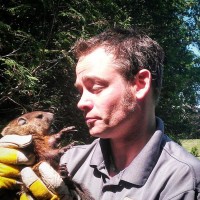
For one day each year, people across North America count on a network of groundhogs to rise at dawn and issue a six-week weather outlook. It’s a popular tradition from Punxsutawney, Pennsylvania, to Vancouver, British Columbia, with crowds often braving bitter cold on Feb. 2 just to see the furry forecasters in action.
But why? How did such a strange ritual ever get started? And is there any truth behind groundhogs’ weather-predicting reputation?
Most experts suggest the tradition began when German settlers brought their tradition of Candelmas to North America in the 1700s.
Feb. 2nd is supposed to be the mid-point between the Winter Solstice and the Spring Equinox. According to legend, if the weather was good on that day, the rest of the winter would be stormy and cold.
If not, the coldest season of the year would be over soon and farmers could start to think about planting their crops.
Eventually a hedgehog – not the more traditional creature used today – was added, and the story of seeing his shadow began.
But Groundhog Day owes its current status not to superstition, but to – what else – commercial reality. A newspaper editor named Clymer Freas came up with the idea in Pennsylvania’s Punxsutawney Spirit in 1886. It wound up being so popular, the legendary Punxsutawney Phil was born, in an event at Gobbler’s Knob that’s been marked ever since.
Crowds of 30,000 people now swarm the city to watch Phil make his annual prediction, an event further popularized by the 1993 Bill Murray comedy “Groundhog Day.” The rise of Punxsutawney Phil has also inspired an array of other forecasting groundhogs across the United States and Canada,
Knowing a good thing when they saw one, the town of Wiarton decided to get in on the act, launching its own prognosticating furball in 1956.
It’s been the largest tourist event in the area ever since, and has only overshadowed, no pun intended, its more famous American cousin once – in 1999, when Willie was discovered dead minutes before his annual prediction was to be delivered.
Since then, dozens of small towns in every part of North America have taken up the banner. Among the other groundhogs that compete with the more famous pair:
- Nova Scotia: Shubenacadie Sam
- Brandon Manitoba: Brandon Bob
- Alberta: Balzac Billy
- Kleinburg, Ont.: Gary the Groundhog
- Birmingham, Alabama: Birmingham Bill
- Marion, Ohio: Buckeye Chuck
- Louis: Chester
- Dunkirk, New York: Dunkirk Dave
- West Virigina: French Creek Freddy
- Georgia: General Beauregard Lee
- Sun Prairie, Wisconsin: Jimmy the Groundhog
- Long Island, N.Y.: Malverne Mel
- Lancaster, Pennsylvania: Octarara Orphie
- Vermont: Peewee, the Woodchuck
- Hollis, New Hampshire: Pennichuck Chuck
- North Carolina: Sir Walter Wally
- Staten Island, N.Y.: Staten Island Chuck
- Unadilla, Nebraska: Unadilla Bill
Groundhog trivia:
- “Groundhog,” “woodchuck” and even “whistle pig” are different names for the same animal — Marmota monax, the largest species of ground squirrel in North America.
- Using only their teeth, claws and sturdy limbs, wild groundhogs dig extensive burrows that can be up to 5 feet deep and 45 feet long.
- The name “whistle pig” comes from their noisy reactions to being disturbed, which include whistling, squealing, barking, chattering and grinding their teeth.
- While most squirrels eat the reproductive parts of plants like seeds and nuts, groundhogs mainly graze on grass and leaves, but they sometimes eat insects, snails and bird eggs, too.
- Groundhogs are one of the few true hibernators, relying entirely on body fat to make it through winter. Their heartbeat slows from about 75 beats per minute to as few as 4, and their body temperature drops from the 90s into the 40s (Fahrenheit).
- An internal biological clock controls when wild groundhogs wake up from hibernation, but their actual emergence from the burrow depends more on daily temperature than intuition.
- Even aside from dedicating a holiday to it, Americans and Canadians have been very good to the groundhog. The species was relatively scarce when Europeans first settled the continent, but as settlers fragmented forests to set up farms and towns, they created more of groundhogs’ favorite habitat — the edge between open and woodland areas — while also killing wolves, cougars and other top predators. Although groundhogs thrived and expanded their range, however, they still usually try to avoid contact with people.
- According to handlers John Griffiths and Ben Hughes, Phil weighs 15 pounds and thrives on dog food and ice cream in his climate-controlled home at the Punxsutawney Library.


